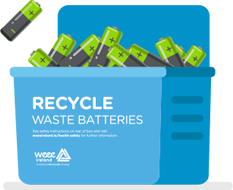Types of Batteries
Ever wondered what metals are recovered when your used batteries are recycled? And what they can be turned into?
 Alkaline and carbon-zinc
Alkaline and carbon-zinc
Alkaline and carbon-zinc are some of the most commonly used batteries. They are used in many everyday items like remote controls, torches and toys. When recycled materials like zinc, iron, manganese and even plastics are recovered from alkaline and carbon-zinc batteries. Iron can be reused in manufacturing items like roads and bridges and zinc can be used in the production of roofs, windows and pipes.
 Lithium
Lithium
Rechargeable lithium batteries are a popular type of battery for many portable devices, such as phones, laptops or even electric toothbrushes. During the recycling process lithium batteries are sorted, dismantled, shredded and finally sieved. Iron, cobalt, copper, nickel and aluminium are recovered through pyrometallurgical and/or hydrometallurgical processes. These valuable metals can then be reused to make anything from watering cans to bikes.
 Button cells
Button cells
These can be found in items like watches and children’s toys. Button cells contain mercury, so the first process of recycling is to distill the mercury within them. The mercury and remaining metals can be recovered to make steel, which can be used in car manufacture and even train tracks.
Nickel-cadmium
Nickel cadmium batteries are commonly used in emergency lighting, but could also be used in items like power tools. NiCd batteries contain resources like iron, cadmium and nickel. The cadmium recovered during recycling process can be used to manufacture more nickel-cadmium batteries and for the production of ferronickel, an alloy used to make stainless steel, which can be used to make cutlery.
 Nickel metal hydride
Nickel metal hydride
Nickel metal hydride batteries are commonly high power batteries for use in high drain devices, such as digital cameras and shavers. Nickel metal hydride batteries contain iron, nickel and cobalt that once recovered can go on to be used again to make things like cooking pots and even spectacle frames!
Lead-acid batteries
Lead acid batteries are commonly used as back-up power supplies for alarm systems and computer systems. During the recycling process for these, battery acid is first removed safely, and then the batteries are melted in an oven. The recovered lead is refined and then can be used to manufacture new lead-acid batteries or even used as protection in radiotherapy sessions or when taking X-rays.





